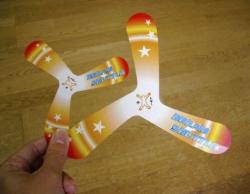During the STS-123 mission to the International Space Station in March 2008 Japanese astronaut Takeo Doi tested a special boomerang in space to see how it worked in the microgravity environment of the ISS. The boomerang used in the experiment was a “Roomerang,†a small, tri-blade boomerang intended for use indoors in a small area or outdoors in light winds. IT was designed by boomerang expert Gary Broadbent, and it travels 5 to 8 feet before returning to the thrower.
The Japanese Space Agency has now released the video of the event:
As you can see, it worked very well, even in the small space of the ISS module. Broadbent told Universe Today that in the pressurized environment of the ISS, “microgravity has very little effect on the boomerang flight. The boomerang is so versatile, it can be tuned to fly in a perfect path back to the thrower, with gyroscopic precession and angular momentum over-compensating the lack of gravity.â€
But Broadbent also said that a boomerang would not work in the vacuum of space. “You need air molecules to generate the lift to make the boomerang turn,†he said.
Here’s our earlier article about the boomerang experiment.
Original News Source: You Tube


So now we can say that we have a functional IMB defense system and can also thwart any potential alien attack. If we begin mass producing them, we could even use them to deflect killer astroids and comets.
Right on JAXA. I think this is really awsome. Now we know that boomerangs work without gravity.
Right. Al that money to work outr a boomerang’s trajectory relies on AREODYNAMICS, not gravity alone.
An exzpensive game methinks
Um, all that money? He did it in his free time, and the boomerang costs what, $3? If the total costs exceed (or even are close to) $100 I’d be very surprised.